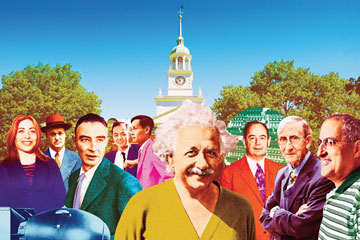
(2 of 6)
If the institute was once a symbol of all that was powerful about American innovation, now it is emblematic of some of the toughest questions facing the U.S. in its fight to stay competitive. Demands for quick results are everywhere, from corporations focused on quarterly reports to universities increasingly obsessed with private-enterprise partnerships that can spawn start-ups and burnish their image with students and donors. "I feel the institute is a little bit the canary in the mine," says Dijkgraaf, 53, who took his post last summer. "It is not clear a place like this can exist. Society is moving toward short-term thinking, toward direct applications. We are really swimming against the stream." In other words, pursuing questions for which the value of the answers isn't obvious may be a luxury that America can no longer afford--or at least appreciate the importance of.
The "Intellectual Hotel"
Founded in 1930 by Abraham Flexner, an educational theorist, and siblings Louis Bamberger and Caroline Bamberger Fuld, department-store moguls who provided the initial endowment of $5 million, the institute was meant to counteract a trend in the U.S. toward applied science. Dubbed an "intellectual hotel" by one director, J. Robert Oppenheimer, it was a magnet during World War II for mathematicians and physicists, including Einstein, who were fleeing the Nazis. The early decades of the institute's history, just before and after the war, coincided with a formative period for science in the U.S., when MIT morphed from a technical school into a place for ambitious research and AT&T's Bell Labs invented the transistor. Men like von Neumann, who created game theory, Oppenheimer, the chain-smoking father of the atomic bomb, and Kennan, an architect of U.S. foreign policy toward the Soviet Union during the Cold War, turned the institute into a hub for academics who had a direct line to Washington. When historian George Dyson was growing up there in the 1950s and '60s--his father Freeman Dyson was working on, among other things, a way to propel spacecraft by exploding nuclear bombs beneath them--he recalls, "If you spilled your food at the table, you were going to hit somebody who could go to the telephone and call the President of the United States."
Today the institute employs 28 permanent faculty members in schools of history, math, social science and natural sciences, along with roughly 200 visiting members who are selected for research fellowships of one to five years. Some 80% of the institute's operating expenses are funded by income from its endowment, which has been supplemented since the Bamberger days by donors including New York City Mayor Michael Bloomberg, a former trustee. (The campus now includes a Bloomberg Hall.) The rest of the operating budget comes from grants from private foundations and the government, mostly the National Science Foundation, the Department of Energy and NASA. As director, Dijkgraaf answers to a board of trustees that includes former Harvard dean Benedict Gross, Carlyle Group co-founder David Rubenstein and Google's Eric Schmidt. The chairman of the board is Charles Simonyi, the billionaire philanthropist and former Microsoft executive who became a space tourist in 2007.
